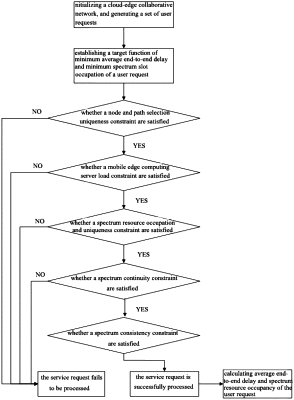| CPC H04L 47/11 (2013.01) [H04L 47/2491 (2013.01)] | 10 Claims |

|
1. A joint optimization method for delay and spectrum occupation in a cloud-edge collaborative network, comprising steps of:
step S1: initializing the cloud-edge collaborative network, and generating a set of user requests;
step S2: establishing a target function of minimum average end-to-end delay and minimum spectrum slot occupation of a user request;
step S3: during processing of each said user request based on the target function, sequentially determining whether a node and path selection uniqueness constraint, a mobile edge computing (MEC) server load constraint, a spectrum resource occupation and uniqueness constraint, a spectrum continuity constraint, and a spectrum consistency constraint are satisfied, wherein if all constraints are satisfied, the user request is successfully processed, proceed to step S4; or if any constraint is not satisfied, the user request fails to be processed; and
step S4: calculating average end-to-end delay and spectrum resource occupancy of the user request.
|